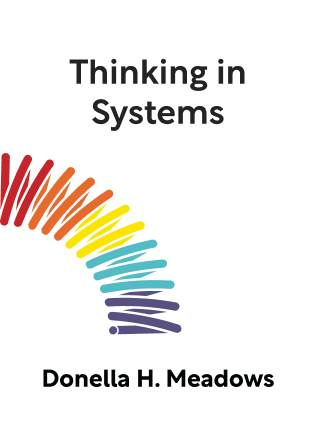

This article is an excerpt from the Shortform summary of "Thinking in Systems" by Donella H. Meadows. Shortform has the world's best summaries of books you should be reading.
Like this article? Sign up for a free trial here .
How do systems work? What properties do systems need to have in order to succeed?
The question of “how do systems work” is complex. But at their foundation, systems need three things to work: reilience, self-organization, and hierachy.
So do you really want to know how systems work? Keep reading.
How Do Systems Work?
So how do systems work? Systems are capable of accomplishing their purposes remarkably well. They can persist for long periods without any particular oversight, and they can survive changes in the environment remarkably well. Why is that? It’s all a part of how systems work.
Strong systems have three properties:
- Resilience: the ability to bounce back after being stressed
- Self-organization: the ability to make itself more complex
- Hierarchy: the arrangement of a system into layers of systems and subsystems
We’ll discuss each one in more detail as we discuss the question “how do systems work.”
Resilience
A resilient system is able to persist after being stressed by a perturbation. This is an important part of understanding systems.
- The human body avoids disease by foreign agents, repairs itself after injury, and survives in a wide range of temperatures and food conditions.
- An economy can work its way out of a grave unexpected event and out of recessions.
Think of resilience as the range of conditions in which a system can perform normally. The wider the range of conditions, the more resilient the system.
Resilience doesn’t mean that the behavior is static or a flat line. Dynamic systems, like the year-long oscillation of a tree growing in spring and shedding leaves in fall, can be resilient as well. Resilience just means that the normal behavior of a system persists through perturbations.
What Creates Resilience?
The stability of resilience comes from feedback loops that can exist at different layers of abstraction:
- There are feedback loops at the baseline level that restore a system, like what we’ve talked about. To increase resilience, there may be multiple feedback loops that serve redundant purposes and can substitute for one another. They may operate through different mechanisms and different time scales.
- Above the baseline loops, there are feedback loops that restore other feedback loops—consider these meta-feedback loops.
- Even further, there are meta-meta feedback loops that create better meta-loops and feedback loops.
To understand this, consider the human again. The body has baseline feedback loops that regulate our breathing and injury repair without our thinking about it. Above this, we also have a brain that can consciously regulate our behavior, discover drugs that influence our bodily feedback loops, and design economies that help us discover drugs. The human body is thus a remarkably resilient system.
Problems from Ignoring Resilience
At times, we design systems for goals other than resilience. Commonly, we optimize for productivity or efficiency. This can make the system very brittle—it narrows the range of conditions in which the system can operate normally. Minor perturbations can knock the system out of balance.
Examples include:
- Modern agriculture, which has biologically selected for cows that produce more milk than is natural. To compound the problem, farmers then apply growth hormones to stimulate milk production, which further diverts the body’s resources from health. The cow has become less resilient, is more susceptible to being sick, and thus requires antibiotics to ward off infections.
- Just-in-time manufacturing, which brings parts to the manufacturer just when it is needed. This is efficient because it reduces inventory, but it makes the system more vulnerable to shocks in the supply chain.
- Large organizations can lose their ability to respond to changes in the marketplace because the information and decisions have to struggle through too many layers.
Beware of designing a system that is brittle and cannot heal itself after a perturbation.
How Systems Work With Self-Organization
How do systems work when it comes to self- organizing? Is it possible? Self-organization means that the system is able to make itself more complex. This is useful because the system can diversify, adapt, and improve itself.
Our world’s biology is a self-organizing system. Billions of years ago, a soup of chemicals in water formed a cellular organism, which then formed multicellular organisms, and eventually into thinking, talking humans.
What Creates Self-Organization?
While self-organization can lead to very complex behaviors, its cause doesn’t need to be complex. In fact, a few simple rules can give rise to very complex behavior.
(Shortform examples: The biological development described above occurred through the combination of a few simple rules:
- Life is encoded in DNA, which gives rise to the proteins and biochemical systems that allow an organism to function.
- Mutations in DNA create variations that change the organism’s ability to survive; the organism passes these mutations to its offspring.
- Through natural selection, the organisms that can reproduce more successfully do so, thus driving evolution of the population.
From these rules, a unicellular organism can ultimately lead to humans.
Similarly, the economy, a complex system, largely works with a few simple rules, such as:
- Use money as a medium of exchange
- Allow people to benefit their own self-interest by producing things of value to other people
Simple rules like these can allow an apple farmer to trade with a furniture maker, and ultimately give rise to a complex economy, consisting of a vast web of relationships that functions productively without any global supervisor.)
Problems from Ignoring Self-Organization
Self-organization produces unexpected variations. It requires experimentation, and tolerance of whole new ways of doing things.
Some organizations quash self-organization, possibly because they optimize toward performance and seek homogeneity, or because they’re afraid of threats to stability. This can explain why some companies reduce their workforces to machines that follow basic instructions and suppress disagreement.
Suppressing self-organization can weaken the resilience of a system and prevent it from adapting to new situations.
Hierarchy
In a hierarchy, subsystems are grouped under a larger system. This is another important part of understanding systems.
There are many nested layers in the hierarchy of our world. Let’s take you as an example:
- The individual cells that make up your body are highly complex systems in their own right.
- Together, the cells work together as organs, forming the larger system of the human organism.
- You work as part of a larger system of multiple people, such as a family, a company, and your local community.
- These systems of people form larger systems such as cities, states, and nations. And, altogether, these form a worldwide human system.
As systems self-organize and increase their complexity, they tend to generate hierarchies naturally. For example:
- A single business founder has too much work, so she hires support staff and oversees them.
- A single cell developed into multicellular organisms, with each cell having specialized roles within the organism.
Why Hierarchy?
How do systems work when it comes to having a hierarchy? In an efficient hierarchy, the subsystems work well more or less independently, while serving the needs of the larger system. The larger system’s role is to coordinate between the subsystems and help the subsystems perform better.
The arrangement of a complex system into a hierarchy improves efficiency. Each subsystem can take care of itself internally, without needing heavy coordination with other subsystems or the larger system.
This arrangement reduces the information that the subsystem needs to operate, preventing information overload. It also reduces delays and minimizes the need for coordination.
For example:
- Your pancreas senses blood glucose and secretes insulin, without needing to ask your legs or your brain whether it’s ok.
- (Shortform note: In a market economy, people can sell and produce goods on the marketplace, largely without needing to coordinate with other subsystems or authorities. Imagine if, before selling your goods in a yard sale, you needed to contact the central government for permission, contact another bureaucracy for pricing, then contact other households who were also planning yard sales.)
Problems from Ignoring Hierarchy
In a hierarchy, both the subsystems and the larger system have their role. If either deviates from the role, the system’s performance suffers. It’s just a part of how systems work.
The subsystems work to support the needs of the larger system. If the subsystem optimizes for itself and neglects the larger system, the whole system can fail. For example:
- Individual football players are subsystems within the larger system of the overall team. If a single football player cares more about individual glory and not the victory of the team, he may run plays in a way that causes the team to lose.
- A single cell in a body can turn cancerous, optimizing for its own growth at the expense of the larger human system.
On the other side, the larger system’s role is to help the subsystems work better, and to coordinate work between them. In other words, the larger system is a supporter and an air traffic controller. It should not exercise more control than this, but it often does:
- A company’s workforce may see its management as oppressive and getting in the way of the real work being done.
- A nation with too autocratic a ruler may direct exactly how subsystems should behave and limit self-organization.
A good hierarchy has balance. There is enough central control to coordinate the subsystems to a larger goal, but not so much control that it suppresses the subsystem’s performance or self-organization.
So, how do systems work? Now that you know the main properties, you should have a better understanding of systems.

———End of Preview———
Like what you just read? Read the rest of the world's best summary of Donella H. Meadows's "Thinking in Systems" at Shortform .
Here's what you'll find in our full Thinking in Systems summary :
- How the world, from bathtub faucets to fish populations, can be seen as simple systems
- The key system traps that hold back progress, such as escalating arms races and policy addiction
- Why seeing the world as systems can give you superpowers in work and life






